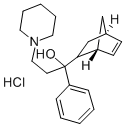| Identification | Back Directory | [Name]
Biperiden hydrochloride | [CAS]
1235-82-1 | [Synonyms]
Bicamol
Tasmolin
Akiriden
NSC 84989
NSC 170950
Biperidene HCL
BIPERIDINE HCL
NSC 170950;NSC 84989
akinetonhydrochloride
KL 373 (Hydrochloride)
biperidinehydrochloride
BIPERIDEN HYDROCHLORIDE
Biperidene hydrochloride
Biperiden hydrochloride CRS
Biperiden hydrochloride salt
Biperiden Hydrochloride (200 mg)
Biperiden hydrochloride USP/EP/BP
Biperiden Hydrochloride
(Mixture of Diastereomers)
Biperiden Hydrochloride\n(Mixture of Diastereomers)
α-5-Norbornen-2-yl-α-phenyl-1-piperidinepropanol Hydrochloride
1-bicycloheptenyl-1-phenyl-3-piperidinopropanol-1hydrochloride
alpha-5-norbornen-2-yl-alpha-phenyl-piperidinepropanolhydrochloride
alpha-5-norbornen-2-yl-alpha-phenyl-1-piperidinepropanohydrochloride
1-(5-bicyclo[2.2.1]hept-2-enyl)-1-phenyl-3-piperidin-1-ylpropan-1-ol
α-(Bicyclo[2.2.1]hept-5-en-2-yl)-α-phenyl-1-piperidinepropanol hydrochloride
alpha-(bicyclo(2.2.1)hept-5-en-2-yl)-alpha-phenyl-1-piperidinepropanolhydroc
1-Piperidinepropanol, α-bicyclo[2.2.1]hept-5-en-2-yl-α-phenyl-, hydrochloride
1-(Bicyclo[2.2.1]hept-5-en-2alpha-yl)-1-phenyl-3-piperidinopropanol hydrochloride
1-Piperidinepropanol, α-5-norbornen-2-yl-α-phenyl-, hydrochloride (6CI, 7CI, 8CI)
1-(5-Bicyclo[2.2.1]hept-2-enyl)-1-phenyl-3-(1-piperidinyl)propan-1-ol hydrochloride
1-Piperidinepropanol, a-bicyclo[2.2.1]hept-5-en-2-yl-a-phenyl-, hydrochloride (1:1)
Piperidinepropanol, alpha-bicyclo(2.2.1)hept-5-en-2-yl-alpha-phenyl-, hydrochloride
1-(Bicyclo[2.2.1]hept-5-en-2-yl)-1-phenyl-3-(piperidin-1-yl)propan-1-ol hydrochloride (1:1)
Akineton, Akinophyl, 1-(5-Bicyclo[2.2.1]hept-2-enyl)-1-phenyl-3-(1-piperidinyl)propan-1-ol hydrochloride | [EINECS(EC#)]
214-976-2 | [Molecular Formula]
C21H30ClNO | [MDL Number]
MFCD00797516 | [MOL File]
1235-82-1.mol | [Molecular Weight]
347.92 |
| Chemical Properties | Back Directory | [Melting point ]
238° | [storage temp. ]
2-8°C | [solubility ]
DMSO: >20mg/mL | [form ]
powder | [color ]
off-white | [BCS Class]
3/1 | [InChI]
InChI=1/C21H29NO.ClH/c23-21(19-7-3-1-4-8-19,11-14-22-12-5-2-6-13-22)20-16-17-9-10-18(20)15-17;/h1,3-4,7-10,17-18,20,23H,2,5-6,11-16H2;1H/t17-,18+,20?,21?;/s3 | [InChIKey]
RDNLAULGBSQZMP-PHPHQDSFNA-N | [SMILES]
C1(C[C@]2([H])C=C[C@@]1([H])C2)C(O)(CCN1CCCCC1)C1C=CC=CC=1.Cl |&1:2,6,r| | [NIST Chemistry Reference]
Akineton, hydrochloride(1235-82-1) |
| Hazard Information | Back Directory | [Chemical Properties]
White Solid | [Originator]
Akineton HCl,Knoll,US,1959 | [Uses]
A muscarinic receptor antagonist | [Uses]
Antiparkinsonian;Anticholinergic | [Uses]
Biperiden hydrochloride is antiparkinsonian; non-selective muscarinic receptor antagonist. Biperiden is used for the adjunctive treatment of all forms of Parkinson′s Disease (postencephalitic, idiopathic, and arteriosclerotic); also commonly used to improve parkinsonian signs and symptoms related to antipsychotic drug therapy. | [Definition]
ChEBI: The hydrochloride salt of biperiden. A muscarinic antagonist affecting both the central and peripheral nervous systems, it is used in the treatment of all forms of Parkinson's disease. | [Manufacturing Process]
65 grams of 3-piperidino-1-phenyl propanone-1 of the summary formula
C14H29ON, produced according to Mannich's reaction by reacting acetophenone
with formaldehyde and piperidine hydrochloride are dissolved in 300 cc of
benzene. The resulting solution is added to an organo-magnesium solution
prepared from 96 grams of [δ5-bicyclo-(2,2,1)-heptenyl-2]-chloride (also
known as 5-chloro-2-norbomene) 18.5 grams of magnesium shavings, and
300 cc of ether.
The reaction mixture is boiled for half an hour under reflux. Thereafter the
ether is removed by distillation, until the inside temperature reaches 65°-
70°C. The resulting benzene solution is added to 95 cc concentrated
hydrochloric acid containing ice for further processing. Thereby, 3-piperidino-
1-phenyl-1-[δ5-bicyclo-(2,2,1)-heptenyl-2]-propanol-1 of the summary
formula C21H29ON is obtained. The compound melts at 101°C and its
chlorohydrate has a melting point of about 238°C. The compound is difficultly
soluble in water, slightly soluble in ethanol, and readily soluble in methanol. | [Brand name]
Akineton
(Abbott). | [Therapeutic Function]
Antiparkinsonian | [General Description]
Biperiden hydrochloride,α-5-norbornen-2-yl- -phenyl-1-piperidinepropanolhydrochloride (Akineton hydrochloride), is a white, opticallyinactive, crystalline, odorless powder that is slightlysoluble in water, ether, alcohol, and chloroform and sparinglysoluble in methanol. | [Biological Activity]
Muscarinic receptor antagonist that displays some selectivity for the M 1 subtype (K i values are 0.48, 2.4, 3.9, 6.3 and 6.3 nM for M 1 , M 4 , M 3 , M 2 and M 5 receptors respectively). Alleviates extrapyramidal symptoms associated with antipsychotic drugs. Displays antiparkinsonian activity. | [Biochem/physiol Actions]
Biperiden hydrochloride is antiparkinsonian; non-selective muscarinic receptor antagonist. It is used for the adjunctive treatment of all forms of Parkinson′s Disease (postencephalitic, idiopathic, and arteriosclerotic); also commonly used to improve parkinsonian signs and symptoms related to antipsychotic drug therapy. LD50 in rats 750 mg/kg; in dogs 340 mg/kg. | [Clinical Use]
Biperiden hydrochloride has all of the actions describedfor biperiden. The hydrochloride is used for tablets becauseit is better suited to this dosage form than is the lactate salt.As with the free base and the lactate salt, xerostomia (drynessof the mouth) and blurred vision may occur. | [Safety Profile]
Poison by ingestion andintravenous routes. When heated to decomposition itemits very toxic fumes of NOx and HCl. | [storage]
Store at -20°C | [References]
[1] brocks d r. anticholinergic drugs used in parkinson’s disease: an overlooked class of drugs from a pharmacokinetic perspective. j pharm pharm sci, 1999, 2(2): 39-46.
[2] espi martinez f, espi forcen f, shapov a, et al. biperiden dependence: case report and literature review. case reports in psychiatry, 2012, 2012. |
|
|





